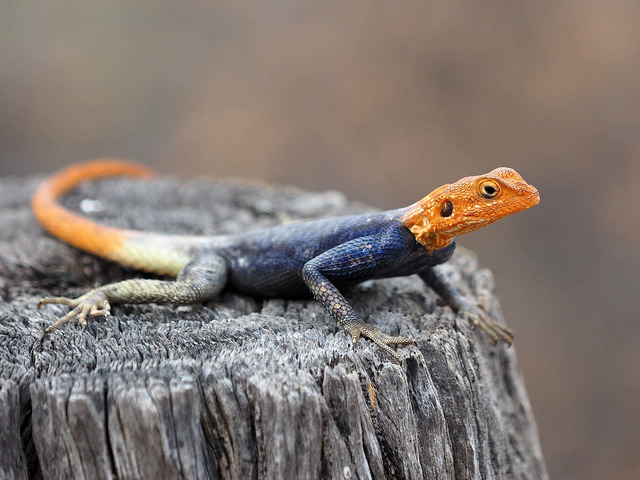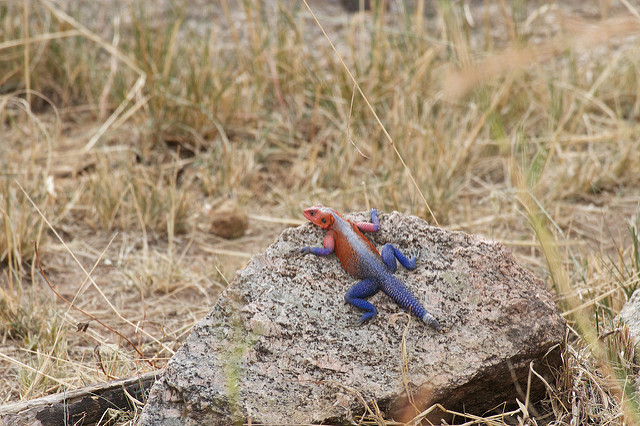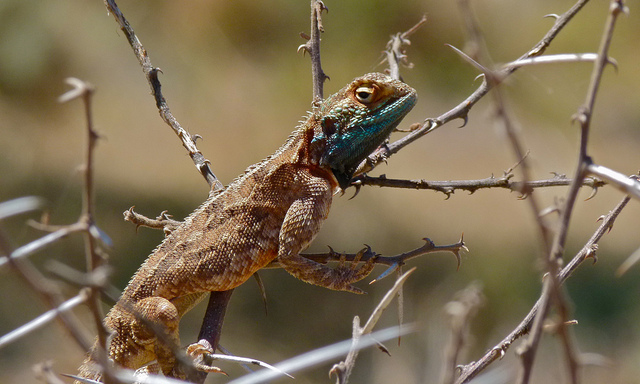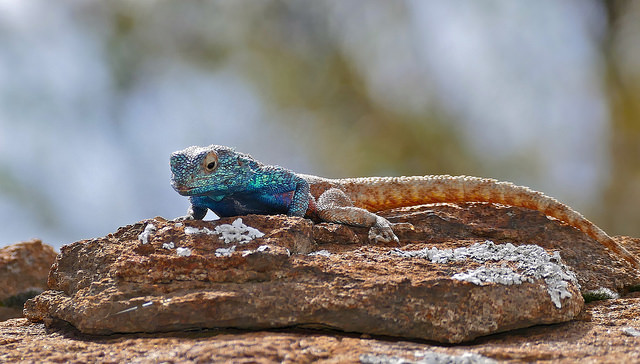Somewhere in sub-Saharan Africa, you can go on a stroll and spot what looks like a small child’s rubber toy left behind sporting brilliant shades of neon pink, orange or teal. Walk up closer and the toy comes alive as it slithers away into the rocks. Congratulations, you just met an agama lizard. Arguably the prettiest lizards known in existence due to its cluster of colors on its skin that’ll leave you wondering if you should use them as a color palette for your next living room. Here are 6 things you didn’t know about the agama lizard.

Courtesy of Jason Pratt/Flickr.com
They’re vicious fighters
Males do not get along with each other and will do everything they can to assume dominance, even if it takes part in a gruesome fight that’ll result with broken tails. The agamas use their tails to whip each other and bite each other with their razor-sharp teeth. The dominant male is called “the cock” of his clan (okay, we can hear you giggling). Females will sometimes get in on the action and fight another, but rarely ends up as violent as the males. Fighting is such a large part of its lifestyle that baby agamas will practice fighting each other to mimic their adult role models.

Courtesy of simonsimages/Flickr.com
They’re polyamorous
We knew Warren Jeffs is a reptile of some sorts, but now we have a solid answer. Agamas are polyamorous, where males can have up to five to six female partners they breed with. When a male is trying to woo a female agama, he’ll bob his head back and forth in an intoxicating rhythm to impress her. The female likes to play hard-to-get and will dart off to let him “catch her” before the two of them get down to business. A few months later, the female will lay up to 10-20 eggs and live among the other lizard sister wives sans the prairie dresses.

Courtesy of Richard Toller/Flickr.com
Their colors are based on their gender
It’s easy to assume finding a hot pink agama is a female but nope, it’s likely a male. His bright coloring of pink, red, orange, blue or yellow works in his favor as females are attracted to the bright colors. The females tend to be green or brown (boring). Because of their impressive coloring, agamas are alternatively known as “the rainbow lizards.” When coming across a pack of agamas, look for the brightest lizard and it’s likely the sole dominant male of an otherwise all-female clan.

Courtesy of Esin Ustun/Flickr.com
They have an incredibly long lifespan
Did you know they can live really long lives? They can live up to 28 years in the wild (that is if they haven’t been gobbled up by snakes). In some cases, agamas can live up to 30 years, surpassing its average lifespan.

Courtesy of Bernard DUPONT/Flickr.com
They have sticky tongues
Agamas feed off insects such as flies, ants, termites, moths and beetles. Occasionally, they’ll snack on smaller lizards. When an agama is hunting for food, he or she will lie in wait in tall grass until it’s time to make the attack. Once they are ready, they unleash their long sticky tongues that sucks up the unsuspecting insect. The insect will yo-yo back into the mouth before the agama snaps the critter into two with its powerful jaws. When hunting for prey is scarce, the agama will feast on berries, grass, and seeds.

Courtesy of Bernard DUPONT/Flickr.com
Their genders are based on the temperature
Believe it or not, you can determine if agamas’ eggs are going to be male or females based on the temperature of the soil. During high heat season, the eggs are likely males while colder temperatures produces females. Science!
More from AFKTravel:
6 Things You Didn’t Know About Bongos
7 Things You Didn’t Know About The Colobus Monkey
7 Things You Didn’t Know About The Caracal
Want to discover the finer side of Africa? Sign up for our weekly newsletter.
